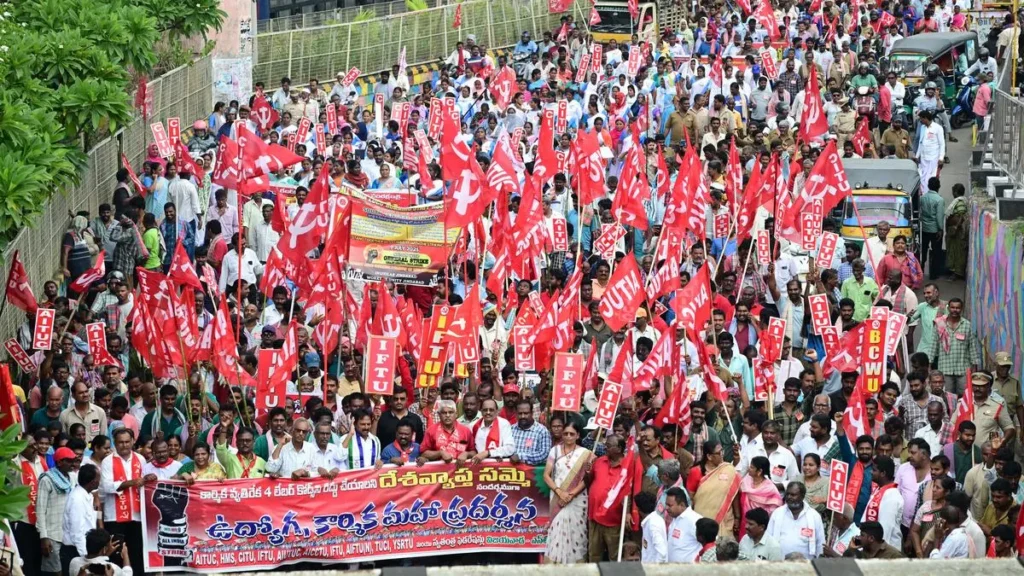trade union walkout India, Central trade union leaders allege that the event was similar to a bandh in Puducherry, Assam, Bihar, Jharkhand, Tamil Nadu, Punjab, Kerala, West Bengal, Odisha, Karnataka, Goa, Meghalaya, and Manipur, affecting important industries including power, mining, minerals, coal, ports, and public transportation.

On Wednesday, July 9, 2025, more than 25 crore workers participated in a nationwide general strike in protest of the Union administration’s policies, particularly the repeal of the four labour codes, as per the platform of ten central trade unions (CTUs). Speaking at a workers’ protest in New Delhi, the union officials claimed that the strike had an impact on important industries like public transit, ports, coal, power, mining, and minerals.
In a statement, the CTUs claimed that workers in informal industries, farmers, agricultural labourers, and other groups of ordinary people had mobilised in significant numbers in rural India as well as at the block-sub-division level. In several states, youth and student participation was clearly noticeable. The unified front of agricultural labour unions and the Samyukt Kisan Morcha [SKM] rank and file were instrumental in the mobilising of rural India, they continued.
Stern alert
As per senior trade union leader Amarjeet Kaur, the workers sent a strong message to the Centre that they would fight any attempt to enforce the four Labour Codes. She claimed that additional planned protests with farmers would follow the strike. “We will soon meet together with the SKM to determine how the protests will proceed going forward,” she stated. In Bihar, which is about to go to elections, the CTUs also valued opposition politicians supporting their cause. “We will oppose the move to remove workers from the Bihar voter list,” stated Rajeev Dimri, another trade union head.
Workers from a wide range of industries, including coal, non-coal minerals (such as iron ore, copper, bauxite, aluminium, manganese, and gold), the finance sector, petroleum, oil and gas, telecom, textile and jute mills, the defence sector, and anganwadi workers, participated in the strike, according to former MP and general secretary of the Centre of Indian Trade Unions Tapan Sen. Reported to the CTUs, “the strike/bandh call resulted in the closure of markets in numerous locations.”
States like Puducherry, Assam, Bihar, Jharkhand, Tamil Nadu, Punjab, Kerala, West Bengal, Odisha, Karnataka, Goa, Meghalaya, and Manipur, among others, were experiencing a bandh-type situation, they claimed. Partial bandhs were also reported in some areas of Telangana, Andhra Pradesh, Rajasthan, and Haryana, many other states. They said that Madhya Pradesh, Uttar Pradesh, Uttarakhand, Maharashtra, and Gujarat encountered sectoral and industrial strikes.
Young unemployment and casual labour suicides increased as a result of people voicing their unhappiness of the widening gaps in the face of historically high costs for necessities, rising rates of underemployment and unemployment, and desperation, all of which became worse by the unions. The CTUs claimed that the government has not held an Indian Labour Conference in ten years, in violation of international labour standards, and that it still makes decisions that are against the interests of the workforce, such as attempting to impose four labour codes that favour employers under the pretext of “ease of doing business.”
Due to the leaders, the general strike marked the start of a protracted battle that would continue at the sectoral level in the days that followed, centred on resolute, united resistance, and ultimately culminate in a larger, more intense, coordinated effort at the national level.
